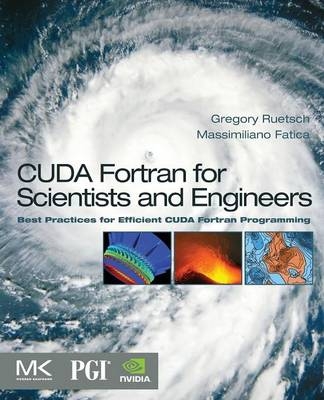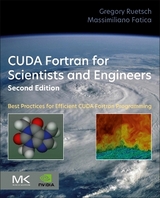
CUDA Fortran for Scientists and Engineers
Morgan Kaufmann Publishers In (Verlag)
978-0-12-416970-8 (ISBN)
- Titel erscheint in neuer Auflage
- Artikel merken
CUDA Fortran for Scientists and Engineers shows how high-performance application developers can leverage the power of GPUs using Fortran, the familiar language of scientific computing and supercomputer performance benchmarking. The authors presume no prior parallel computing experience, and cover the basics along with best practices for efficient GPU computing using CUDA Fortran.
To help you add CUDA Fortran to existing Fortran codes, the book explains how to understand the target GPU architecture, identify computationally intensive parts of the code, and modify the code to manage the data and parallelism and optimize performance. All of this is done in Fortran, without having to rewrite in another language. Each concept is illustrated with actual examples so you can immediately evaluate the performance of your code in comparison.
Greg Ruetsch is a Senior Applied Engineer at NVIDIA, where he works on CUDA Fortran and performance optimization of HPC codes. He holds a Bachelor’s degree in mechanical and aerospace engineering from Rutgers University and a Ph.D. in applied mathematics from Brown University. Prior to joining NVIDIA he has held research positions at Stanford University’s Center for Turbulence Research and Sun Microsystems Laboratories. Massimiliano Fatica is the manager of the Tesla HPC Group at NVIDIA where he works in the area of GPU computing (high-performance computing and clusters). He holds a laurea in Aeronautical Engineering and a Phd in Theoretical and Applied Mechanics from the University of Rome “La Sapienza. Prior to joining NVIDIA, he was a research staff member at Stanford University where he worked at the Center for Turbulence Research and Center for Integrated Turbulent Simulations on applications for the Stanford Streaming Supercomputer.
I CUDA Fortran Programming 1. Introduction 2. Performance Measurement and Metrics 3. Optimization 4. Multi-GPU ProgrammingII Case Studies 5. Monte Carlo Method 6. Finite Difference Method 7. Applications of Fast Fourier TransformIII Appendices A. Tesla Specifications B. System and Environment Management C. Calling CUDA C from CUDA Fortran D. Source Code
| Verlagsort | San Francisco |
|---|---|
| Sprache | englisch |
| Maße | 191 x 235 mm |
| Gewicht | 700 g |
| Themenwelt | Mathematik / Informatik ► Informatik ► Theorie / Studium |
| ISBN-10 | 0-12-416970-8 / 0124169708 |
| ISBN-13 | 978-0-12-416970-8 / 9780124169708 |
| Zustand | Neuware |
| Haben Sie eine Frage zum Produkt? |
aus dem Bereich



